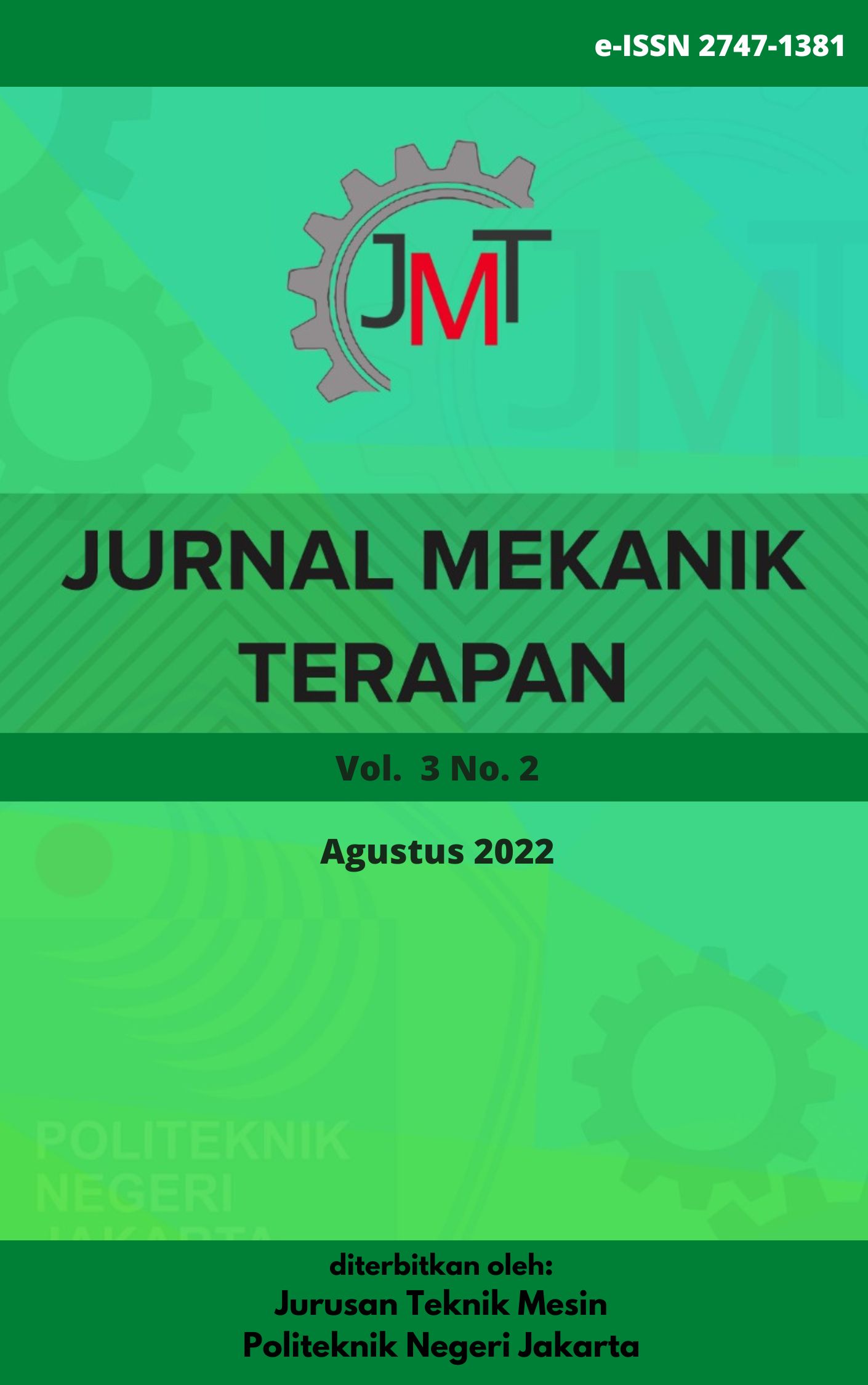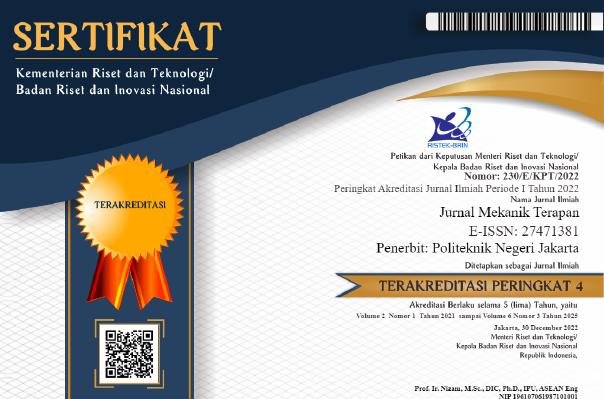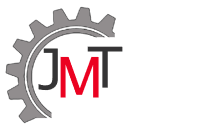2D Mapping Lingkungan Indoor Menggunakan Lidar dan ROS untuk Mobile Robot
DOI:
https://doi.org/10.32722/jmt.v3i2.4285Keywords:
mobile robot, Gmapping, 2D mappingAbstract
Currently, the application of control systems has been applied in various scientific fields including mechatronics and robotics. Applications in the branch of robotics are also growing day by day not only with conventional controls but also with intelligent systems. An autonomous robot in carrying out certain missions in an unknown environment requires information about the location itself and the environment through the map. A process to identify a position without a map is called a localization function on the robot. Mobile robots building maps and localization are two fundamental tasks when mobile robots work in indoor environments. With 2D laser scanning (LiDAR) data obtained in real-time, the robot can calculate the area of all empty spaces in a room, then can choose the center of the room as its position for map building. The objective of this research is to implement a two-dimensional mapping method using LiDAR. The algorithm used in this study is the Gmapping Technique on ROS. The main purpose of this research is to map mobile robots with LIDAR sensors using the Robot Operating System for navigation and positioning of mobile robots. Through the actual experimental results, the mobile robot will move with a 2-dimensional mapping process.
References
Nurhadi H, Pramujati B, MULIA A. RANCANG BANGUN DAN ANALISA SISTEM KENDALI PID PADA UNMANNED AERIAL VEHICLE (UAV) FIXED WING: Institut Teknologi Sepuluh Nopember; 2016.
Apriaskar E, Nugraha YP, Trilaksono BR, editors. Simulation of simultaneous localization and mapping using hexacopter and RGBD camera. 2017 2nd International Conference on Automation, Cognitive Science, Optics, Micro Electro-Mechanical System, and Information Technology (ICACOMIT); 2017 23-24 Oct. 2017.
Riansyah MI, Nugraha YP, Ridlwan HM, Trilaksono BR. 3D Mapping Hexacopter Simulation using Gazebo and Robot Operating Sytem(ROS). Proceedings of the 9th International Conference on Machine Learning and Computing; Singapore, Singapore: Association for Computing Machinery; 2017. p. 507–10.
Corbato CH, Bharatheesha M, Egmond Jv, Ju J, Wisse M. Integrating Different Levels of Automation: Lessons From Winning the Amazon Robotics Challenge 2016. IEEE Transactions on Industrial Informatics. 2018;14(11):4916-26.
Teslyuk V, Beregovskyi V, Denysyuk P, Teslyuk T, Lozynskyi A. Development and Implementation of the Technical Accident Prevention Subsystem for the Smart Home System. International Journal of Intelligent Systems and Applications. 2018;10:1-8.
Ortigoza RS, Marcelino-Aranda M, Ortigoza GS, Guzman VMH, Molina-Vilchis MA, Saldana-Gonzalez G, et al. Wheeled Mobile Robots: A review. IEEE Latin America Transactions. 2012;10(6):2209-17.
Ryadchikov I, Nikulchev E, Gusev A, Sechenev S, Prutskiy A. Engineering Software for a Mobile Robot Motion Control System Engineering Software for a Mobile Robot Motion Control System2019.
Denysyuk P, Teslyuk V, Chorna I, editors. Development of mobile robot using LIDAR technology based on Arduino controller. 2018 XIV-th International Conference on Perspective Technologies and Methods in MEMS Design (MEMSTECH); 2018 18-22 April 2018.
Hwang S, Kim N, Choi Y, Lee S, Kweon IS, editors. Fast multiple objects detection and tracking fusing color camera and 3D LIDAR for intelligent vehicles. 2016 13th International Conference on Ubiquitous Robots and Ambient Intelligence (URAI); 2016 19-22 Aug. 2016.
Mohd Saifizi S, Desa H, Rudzuan MN, editors. A differential steering control with proportional controller for an autonomous mobile robot. 2011 IEEE 7th International Colloquium on Signal Processing and its Applications; 2011 4-6 March 2011.
Singh J, Chouhan PS, editors. A new approach for line following robot using radius of path curvature and differential drive kinematics. 2017 6th International Conference on Computer Applications In Electrical Engineering-Recent Advances (CERA); 2017 5-7 Oct. 2017.
Adams M. Lidar design, use, and calibration concepts for correct environmental detection. IEEE Transactions on Robotics. 2000;16:753-61.
Liu J, Sun Q, Fan Z, Jia Y. TOF Lidar Development in Autonomous Vehicle2018. 185-90 p.
Atia M, Liu S, Nematallah H, Karamat T, Noureldin A. Integrated Indoor Navigation System for Ground Vehicles With Automatic 3-D Alignment and Position Initialization. IEEE Transactions on Vehicular Technology. 2015;64:1279-92.
Markom M, Adom A, Tan E, Abdul Shukor S, Abdul Rahim N, md shakaff ay. A mapping mobile robot using RP Lidar scanner2015. 87-92 p.
Zhang J, Singh S. Visual-lidar Odometry and Mapping: Low-drift, Robust, and Fast2015.
Downloads
Published
How to Cite
Issue
Section
License
Copyright (c) 2022 Hasvienda Mohammad Ridlwan, Pribadi Mumpuni Adhi, Sonki Prasetya, Muslimin Muslimin

This work is licensed under a Creative Commons Attribution-ShareAlike 4.0 International License.
Jurnal ini berlisensi Atribut Berbagi Serupa 4.0 Internasional (CC BY-SA 4.0)
Anda diperbolehkan:
- Berbagi — menyalin dan menyebarluaskan kembali materi ini dalam bentuk atau format apapun;
- Adaptasi — menggubah, mengubah, dan membuat turunan dari materi ini untuk kepentingan apapun, termasuk kepentingan komersial.
Berdasarkan ketentuan berikut:
-
Atribusi — Anda harus mencantumkan nama yang sesuai, mencantumkan tautan terhadap lisensi, dan menyatakan bahwa telah ada perubahan yang dilakukan. Anda dapat melakukan hal ini dengan cara yang sesuai, namun tidak mengisyaratkan bahwa pemberi lisensi mendukung Anda atau penggunaan Anda.
-
BerbagiSerupa — Apabila Anda menggubah, mengubah, atau membuat turunan dari materi ini, Anda harus menyebarluaskan kontribusi Anda di bawah lisensi yang sama dengan materi asli.
- Tidak ada pembatasan tambahan — Anda tidak dapat menggunakan ketentuan hukum atau sarana kontrol teknologi yang secara hukum membatasi orang lain untuk melakukan hal-hal yang diizinkan lisensi ini.






